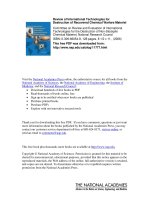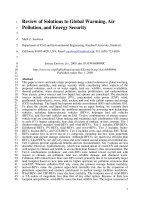Kaplan MCAT review 2015 behavioral sciences review
Bạn đang xem bản rút gọn của tài liệu. Xem và tải ngay bản đầy đủ của tài liệu tại đây (21.61 MB, 879 trang )
MCAT® Behavioral Sciences Review
Edited by Alexander Stone Macnow, MD
Table of Contents
1. MCAT® Behavioral Sciences Review
1. Cover
1. Title Page
2. Table of Contents
3. The Kaplan MCAT Review Team
4. About Scientific American
5. About the MCAT
6. How This Book Was Created
7. Using This Book
2. Chapter 1: Biology and Behavior
1. Biology and Behavior
2. Introduction
3. 1.1 A Brief History of Neuropsychology
4. 1.2 Organization of the Human Nervous System
5. 1.3 Organization of the Brain
6. 1.4 Parts of the Forebrain
7. 1.5 Influences on Behavior
8. 1.6 Development
9. Conclusion
10. Concept Summary
11. Answers to Concept Checks
12. Shared Concepts
13. Practice Questions
14. Answers and Explanations
3. Chapter 2: Sensation and Perception
1. Sensation and Perception
2. Introduction
3. 2.1 Sensation vs. Perception
4. 2.2 Vision
5. 2.3 Hearing and Vestibular Sense
6. 2.4 Other Senses
7. 2.5 Object Recognition
8. Conclusion
9. Concept Summary
10. Answers to Concept Checks
11. Shared Concepts
12. Practice Questions
13. Answers and Explanations
4. Chapter 3: Learning and Memory
1. Learning and Memory
2. Introduction
3. 3.1 Learning
4. 3.2 Memory
5. 3.3 Neurobiology of Learning and Memory
6. Conclusion
7. Concept Summary
8. Answers to Concept Checks
9. Shared Concepts
10. Practice Questions
11. Answers and Explanations
5. Chapter 4: Cognition, Consciousness, and Language
1. Cognition, Consciousness, and Language
2. Introduction
3. 4.1 Cognition
4. 4.2 Problem-Solving and Decision-Making
5. 4.3 Consciousness
6. 4.4 Consciousness-Altering Drugs
7. 4.5 Attention
8. 4.6 Language
9. Conclusion
10. Concept Summary
11. Answers to Concept Checks
12. Equations to Remember
13. Shared Concepts
14. Practice Questions
15. Answers and Explanations
6. Chapter 5: Motivation, Emotion, and Stress
1. Motivation, Emotion, and Stress
2. Introduction
3. 5.1 Motivation
4. 5.2 Emotion
5. 5.3 Stress
6. Conclusion
7. Concept Summary
8. Answers to Concept Checks
9. Shared Concepts
10. Practice Questions
11. Answers and Explanations
7. Chapter 6: Identity and Personality
1. Identity and Personality
2. Introduction
3. 6.1 Self-Concept and Identity
4. 6.2 Formation of Identity
5. 6.3 Personality
6. Conclusion
7. Concept Summary
8. Answers to Concept Checks
8.
9.
10.
11.
9. Shared Concepts
10. Practice Questions
11. Answers and Explanations
Chapter 7: Psychological Disorders
1. Psychological Disorders
2. Introduction
3. 7.1 Understanding Psychological Disorders
4. 7.2 Types of Psychological Disorders
5. 7.3 Biological Basis of Nervous System Disorders
6. Conclusion
7. Concept Summary
8. Answers to Concept Checks
9. Shared Concepts
10. Practice Questions
11. Answers and Explanations
Chapter 8: Social Processes, Attitudes, and Behavior
1. Social Processes, Attitudes, and Behavior
2. Introduction
3. 8.1 Group Psychology
4. 8.2 Socialization
5. 8.3 Attitudes and Behavior
6. Conclusion
7. Concept Summary
8. Answers to Concept Checks
9. Shared Concepts
10. Practice Questions
11. Answers and Explanations
Chapter 9: Social Interaction
1. Social Interaction
2. Introduction
3. 9.1 Elements of Social Interaction
4. 9.2 Self-Presentation and Interacting with Others
5. Conclusion
6. Concept Summary
7. Answers to Concept Checks
8. Shared Concepts
9. Practice Questions
10. Answers and Explanations
Chapter 10: Social Thinking
1. Social Thinking
2. Introduction
3. 10.1 Social Behavior
4. 10.2 Social Perception and Behavior
5. 10.3 Stereotypes, Prejudice, and Discrimination
6. Conclusion
7. Concept Summary
8. Answers to Concept Checks
9. Shared Concepts
10. Practice Questions
11. Answers and Explanations
12. Chapter 11: Social Structure and Demographics
1. Social Structure and Demographics
2. Introduction
3. 11.1 Sociology: Theories and Institutions
4. 11.2 Culture
5. 11.3 Demographics
6. Conclusion
7. Concept Summary
8. Answers to Concept Checks
9. Shared Concepts
10. Practice Questions
11. Answers and Explanations
13. Chapter 12: Social Stratification
1. Social Stratification
2. Introduction
3. 12.1 Social Class
4. 12.2 Epidemiology and Disparities
5. Conclusion
6. Concept Summary
7. Answers to Concept Checks
8. Shared Concepts
9. Practice Questions
10. Answers and Explanations
14. About This Book
1. Copyright Information
2. Glossary
3. Index
4. Art Credits
5. Periodic Table of the Elements
6. Special Offer for Kaplan Students
The Kaplan MCAT Review Team
Alexander Stone Macnow, MD
Editor-in-Chief
Áine Lorié, PhD
Editor
Derek Rusnak, MA
Editor
Mikhail Alexeeff
Kaplan MCAT Faculty
Laura L. Ambler
Kaplan MCAT Faculty
Krista L. Buckley, MD
Kaplan MCAT Faculty
Kristen L. Russell, ME
Editor
Pamela Willingham, MSW
Editor
Melinda Contreras, MS
Kaplan MCAT Faculty
Samantha Fallon
Kaplan MCAT Faculty
Jason R. Pfleiger
Kaplan MCAT Faculty
MCAT faculty reviewers Elmar R. Aliyev; James Burns; Jonathan Cornfield; Alisha Maureen
Crowley; Nikolai Dorofeev, MD; Benjamin Downer, MS; Colin Doyle; M. Dominic Eggert; Marilyn
Engle; Eleni M. Eren; Raef Ali Fadel; Tyra Hall-Pogar, PhD; Scott Huff; Samer T. Ismail; Elizabeth
A. Kudlaty; Kelly Kyker-Snowman, MS; Ningfei Li; John P. Mahon; Matthew A. Meier; Nainika
Nanda; Caroline Nkemdilim Opene; Kaitlyn E. Prenger; Uneeb Qureshi; Bela G. Starkman, PhD;
Michael Paul Tomani, MS; Nicholas M. White; Kerranna Williamson, MBA; Allison Ann Wilkes,
MS; and Tony Yu
Thanks to Kim Bowers; Tim Eich; Owen Farcy; Dan Frey; Robin Garmise; Rita Garthaffner; Joanna
Graham; Adam Grey; Allison Harm; Beth Hoffberg; Aaron Lemon-Strauss; Keith Lubeley; Diane
McGarvey; Petros Minasi; John Polstein; Deeangelee Pooran-Kublall, MD, MPH; Rochelle
Rothstein, MD; Larry Rudman; Sylvia Tidwell Scheuring; Carly Schnur; Karin Tucker; Lee Weiss;
and the countless others who made this project possible.
About Scientific American
Scientific American is at the heart of Nature Publishing Group’s consumer media division, meeting
the needs of the general public. Founded in 1845, Scientific American is the longest continuously
published magazine in the United States and the leading authoritative publication for science in the
general media. In its history, 148 Nobel Prize scientists have contributed 240 articles to Scientific
American, including Albert Einstein, Francis Crick, Stanley Prusiner, and Richard Axel.
Together with scientificamerican.com and in translation in 14 languages around the world, it
reaches more than 5 million consumers and scientists. Other titles include Scientific American Mind
and Spektrum der Wissenschaft in Germany. Scientific American won a 2011 National Magazine
Award for General Excellence.
About the MCAT
The structure of the four sections of the MCAT is shown below.
Chemical and Physical Foundations of Biological Systems
Time
Format
95 minutes
59 questions
10 passages
44 questions are passage-based, and 15 are discrete (stand-alone) questions.
Score between 118 and 132
What It Tests
Biochemistry: 25%
Biology: 5%
General Chemistry: 30%
Organic Chemistry: 15%
Physics: 25%
Critical Analysis and Reasoning Skills (CARS)
Time
Format
90 minutes
53 questions
9 passages
All questions are passage-based. There are no discrete (stand-alone) questions.
Score between 118 and 132
What It Tests
Disciplines:
Humanities: 50%
Social Sciences: 50%
Skills:
Foundations of Comprehension: 30%
Reasoning Within the Text: 30%
Reasoning Beyond the Text: 40%
Biological and Biochemical Foundations of Living Systems
Time
Format
95 minutes
59 questions
10 passages
44 questions are passage-based, and 15 are discrete (stand-alone) questions.
Score between 118 and 132
Biochemistry: 25%
What It Tests
Biology: 65%
General Chemistry: 5%
Organic Chemistry: 5%
Psychological, Social, and Biological Foundations of Behavior
Time
95 minutes
59 questions
Format
10 passages
44 questions are passage-based, and 15 are discrete (stand-alone) questions.
Score between 118 and 132
Biology: 5%
What It Tests
Psychology: 65%
Sociology: 30%
Total
Testing Time
375 minutes (6 hours, 15 minutes)
Questions
230
Score
472 to 528
The MCAT also tests four Scientific Inquiry and Reasoning Skills (SIRS):
1. Knowledge of Scientific Concepts and Principles (35% of questions)
2. Scientific Reasoning and Problem-Solving (45% of questions)
3. Reasoning About the Design and Execution of Research (10% of questions)
4. Data-Based and Statistical Reasoning (10% of questions)
The MCAT is a computer-based test (CBT) and is offered at Prometric centers during almost every
month of the year. There are optional breaks between each section, and there is a lunch break between
the second and third section of the exam.
Register online for the MCAT at www.aamc.org/mcat
.
For further questions, contact the MCAT team at the Association of American Medical Colleges:
MCAT Resource Center
Association of American Medical Colleges
(202) 828-0690
www.aamc.org/mcat
How This Book Was Created
The Kaplan MCAT Review project began in November 2012 shortly after the release of the Preview
Guide for the MCAT 2015 Exam, 2nd edition. Through thorough analysis by our staff
psychometricians, we were able to analyze the relative yield of the different topics on the MCAT, and
we began constructing tables of contents for the books of the Kaplan MCAT Review series.
Writing of the books began in April 2013. A dedicated staff of 19 writers, 7 editors, and 32
proofreaders worked over 5000 combined hours to produce these books. The format of the books was
heavily influenced by weekly meetings with Kaplan’s learning-science team.
These books were submitted for publication in July 2014. For any updates after this date, please
visit www.kaplanmcat.com .
The information presented in these books covers everything listed on the official MCAT content lists
—nothing more, nothing less. Every topic in these lists is covered in the same level of detail as is
common to the undergraduate and postbaccalaureate classes that are considered prerequisites for the
MCAT. Note that your premedical classes may cover topics not discussed in these books, or they may
go into more depth than these books do. Additional exposure to science content is never a bad thing,
but recognize that all of the content knowledge you are expected to have walking in on Test Day is
covered in these books.
If you have any questions about the content presented here, email
. For other questions not related to content, email
.
Each book has been vetted through at least six rounds of review. To that end, the information
presented is these books is true and accurate to the best of our knowledge. Still, your feedback helps
us improve our prep materials. Please notify us of any inaccuracies or errors in the books by sending
an email to .
Using This Book
Kaplan MCAT Behavioral Sciences Review, along with the other six books in the Kaplan MCAT
Review series, brings the Kaplan classroom experience to you—right in your home, at your
convenience. This book offers the same Kaplan content review, strategies, and practice that make
Kaplan the #1 choice for MCAT prep. After all, twice as many doctors prepared with Kaplan for the
MCAT than with any other course.
This book is designed to help you review the psychology and sociology topics covered on the MCAT.
It represents one of the content review resources available to you. Additional review is available in
your Online Center, including more practice questions, video science review, and full-length practice
exams. Register for your Online Center at kaptest.com/booksonline .
Please understand that content review—no matter how thorough—is not sufficient preparation for the
MCAT! The MCAT tests not only your science knowledge but also your critical reading, reasoning,
and problem-solving skills. Do not assume that simply memorizing the contents of this book will earn
you high scores on Test Day; to maximize your scores, you must also improve your reading and testtaking skills through MCAT-style questions and practice tests.
MCAT CONCEPT CHECKS
At the end of each section, you’ll find a few open-ended questions that you can use to assess your
mastery of the material. These MCAT Concept Checks were introduced after multiple conversations
with Kaplan’s learning-science team. Research has demonstrated repeatedly that introspection and
self-analysis improve mastery, retention, and recall of material. Complete these MCAT Concept
Checks to ensure that you’ve got the key points from each section before moving on!
PRACTICE QUESTIONS
At the end of each chapter, you’ll find 15 MCAT-style practice questions. These are designed to help
you assess your understanding of the chapter you just read. Most of these questions focus on the first
of the Scientific Inquiry and Reasoning Skills (Knowledge of Scientific Concepts and Principles),
although there are occasional questions that fall into the second or fourth SIRS (Scientific Reasoning
and Problem-Solving, and Data-Based and Statistical Reasoning, respectively).
SIDEBARS
The following is a guide to the five types of sidebars you’ll find in Kaplan MCAT Behavioral
Sciences Review:
Bridge: These sidebars create connections between science topics that appear in multiple
chapters throughout the Kaplan MCAT Review series.
Key Concept: These sidebars draw attention to the most important takeaways in a given topic,
and they sometimes offer synopses or overviews of complex information. If you understand
nothing else, make sure you grasp the Key Concepts for any given subject.
MCAT Expertise: These sidebars point out how information may be tested on the MCAT or
offer key strategy points and test-taking tips that you should apply on Test Day.
Mnemonic: These sidebars present memory devices to help recall certain facts.
Real World: These sidebars illustrate how a concept in the text relates to the practice of
medicine or the world at large. While this is not information you need to know for Test Day,
many of the topics in Real World sidebars are excellent examples of how a concept may appear
in a passage or discrete (stand-alone) question on the MCAT.
This book also contains a thorough glossary and index for easy navigation of the text.
In this end, this is your book, so write in the margins, draw diagrams, highlight the key points—do
whatever is necessary to help you get that higher score. We look forward to working with you as you
achieve your dreams and become the doctor you deserve to be!
In This Chapter
1.1
1.2
1.3
1.4
1.5
1.6
A Brief History of Neuropsychology
Organization of the Human Nervous System
Central and Peripheral Nervous Systems
The Autonomic Nervous System
Organization of the Brain
Hindbrain
Midbrain
Forebrain
Methods of Mapping the Brain
Parts of the Forebrain
Thalamus
Hypothalamus
Other Parts of the Diencephalon
Basal Ganglia
Limbic System
Cerebral Cortex
Influences on Behavior
Neurotransmitters
The Endocrine System
Genetics and Behavior
Development
Prenatal
Motor
Social
Concept Summary
Introduction
When you woke up this morning and got ready to start reading MCAT Behavioral Sciences Review,
you almost certainly had specific feelings about it—perhaps you were excited to crack open the book
and start learning some of the material that will get you that top score on the MCAT; perhaps you
dreaded the size and rich detail of the information in the book. Either way, your body began to
respond to these impulses from your mind: increasing heart rate, increasing breathing rate, dilating the
eyes, and slowing down digestion. This link between the mind and the body is still a hot topic in
medicine, although we’ve been exploring the importance of psychology on well-being for almost two
centuries now.
In this chapter, we’ll begin our exploration of psychology and sociology by looking at the biological
side of psychology. After a quick survey of the history of neuropsychology, we’ll look at the structure
and organization of the human nervous system, communication between the nervous and endocrine
systems, the effects of genes and environment on behavior, and some aspects of psychological
development.
1.1 A Brief History of Neuropsychology
Researchers in the 19th century began to think about behavior from a physiological perspective. Many
of these early thinkers formed the foundation of current knowledge about neuroanatomy, linking the
functions of specific areas of the brain with thought and behavior.
Franz Gall (1758–1828) had one of the earliest theories that behavior, intellect, and even personality
might be linked to brain anatomy. He developed the doctrine of phrenology. The basic idea was that if
a particular trait was well-developed, then the part of the brain responsible for that trait would
expand. This expansion, according to Gall, would push the area of the skull that covered that part of
the brain outward and therefore cause a bulge on the head. Gall believed that one could thus measure
psychological attributes by feeling or measuring the skull. Although phrenology was shown to be
false, it did generate serious research on brain functions and was the impetus for the work of other
psychologists through the remainder of the 19th century.
Pierre Flourens (1794–1867) was the first person to study the functions of the major sections of the
brain. He did this by extirpation on rabbits and pigeons, also known as ablation. In extirpation,
various parts of the brain are surgically removed and the behavioral consequences are observed.
Flourens’s work led to his assertion that the brain had specific parts for specific functions, and that
the removal of one part weakens the whole brain.
William James (1842–1910), known as the father of American psychology, believed that it was
important to study how the mind functioned in adapting to the environment. His view was among the
first theories that formed functionalism, a system of thought in psychology that studied how mental
processes help individuals adapt to their environments.
John Dewey (1859–1952) is another important name in functionalism because his 1896 article is
seen as its inception. This article criticized the concept of the reflex arc, which breaks the process of
reacting to a stimulus into discrete parts. Dewey believed that psychology should focus on the study
of the organism as a whole as it functioned to adapt to the environment.
Around 1860, Paul Broca (1824–1880) added to the knowledge of physiology by examining the
behavioral deficits of people with brain damage. He was the first person to demonstrate that specific
functional impairments could be linked with specific brain lesions. Broca found that a man who’d
been unable to talk was unable to do so because of a lesion in a specific area on the left side of the
brain. This area of the brain is now referred to as Broca’s area.
Hermann von Helmholtz (1821–1894) was the first to measure the speed of a nerve impulse. By
actually measuring the speed of nerve impulses in terms of reaction time, Helmholtz is often credited
with the transition of psychology into a field of the natural sciences.
Around the turn of the century, Sir Charles Sherrington (1857–1952) first inferred the existence of
synapses. Many of his conclusions have held over time—except for one. He thought that synaptic
transmission was an electrical process, but we now know that it is primarily a chemical process.
MCAT Concept Check 1.1:
Before you move on, assess your understanding of the material with these
questions.
1.
Briefly list the main contributions of each of the following scientists to
neuropsychology.
Franz Gall:
Pierre Flourens:
William James:
John Dewey:
Paul Broca:
Hermann von Helmoltz:
Sir Charles Sherrington:









